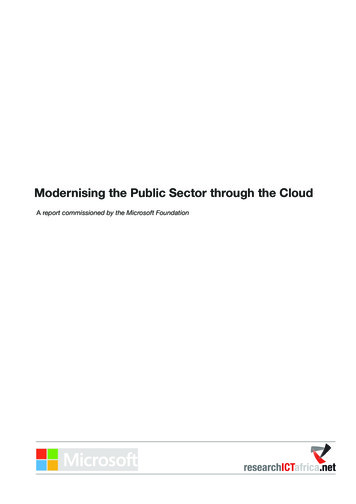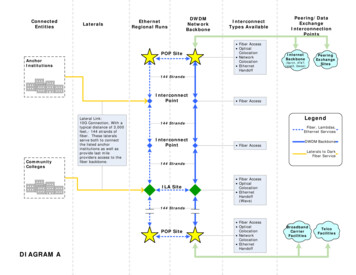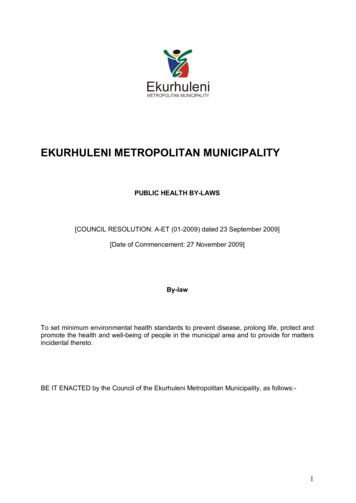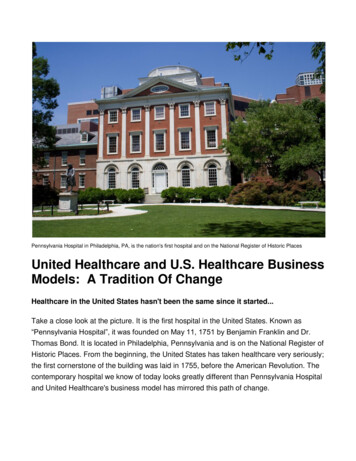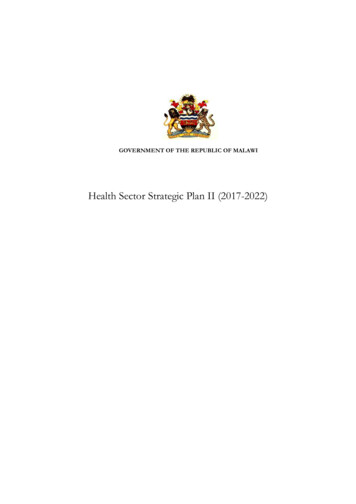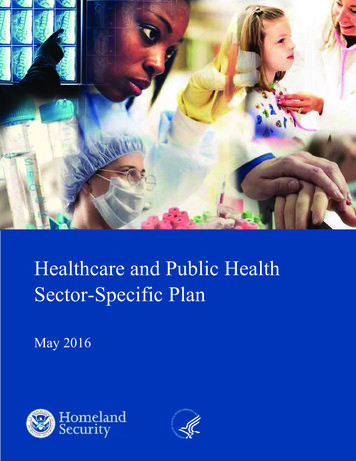
Transcription
HDOWKFDUH DQG 3XEOLF HDOWK 6HFWRU 6SHFLILF 3ODQ 0D\
Coordination Letter from Council ChairsIn 2003, the Federal Government established the Healthcare and Public Health (HPH) Sector as a criticalinfrastructure sector in the United States, recognizing that its security and resilience are essential tonational security, the economy, and public health and safety. Since that time, the Sector has built strongpartnerships that bring together private sector owners, operators, and professional associations withgovernment representatives at the Federal, State, and local levels. Together, these partners haveimproved information sharing, developed guidance and tools, and conducted training and exercises toimprove incident response and recovery. The HPH Sector recognizes the value of this partnership andcontinues to coordinate to improve security and resilience.2016 Sector-Specific Plan UpdateThe release of the 2016 HPH SSP reflects the maturation of the HPH Sector partnership and the progressof the sector programs first outlined in the 2007 and 2010 Sector-Specific Plans (SSPs). Changes fromprevious SSPs include a streamlined and updated set of goals and objectives and an increased emphasison priorities such as information sharing and emergency response. The 2016 SSP represents acontinued collaborative effort among the private sector; Federal, State, local, tribal, and territorialgovernments; and nongovernmental organizations to develop specific membership actions over thecoming years required to reduce critical infrastructure risk and enhance Sector resilience.The HPH Sector Coordinating Council (SCC) and Government Coordinating Council (GCC) jointlydeveloped the goals, priorities, and activities included in this SSP to reflect the overall strategic directionfor the HPH Sector. The Sector’s goals support the Joint National Priorities developed in 2014 by thenational council structures described in the National Infrastructure Protection Plan 2013: Partnering forCritical Infrastructure Security and Resilience (NIPP 2013).This SSP also illustrates the continued maturation of the HPH Sector partnership and the progress madeto address the Sector’s evolving risk, operating, and policy environments.The HPH Sector continues to take steps to better understand all-hazards risks and implementappropriate actions to mitigate corresponding impacts at all levels of government and the private sectorthroughout the Nation’s Critical Infrastructure.Key AccomplishmentsSince 2010, the HPH Sector partners in the public and private sectors have taken significant steps toreduce sector risk, improve coordination, and strengthen security and resilience capabilities: Both the SCC and GCC undertook extensive outreach programs. State, local, and private sectorpartners were recruited through presentations, webinars, and outreach to national associations.The Homeland Security Information Network portal for the HPH Sector was expanded to bettermeet the information sharing needs of the Sector including a lessons learned repository and theaddition of over 1300 documents to enhance relevant situational awareness for end-users.A full methodology is under development for use in assessing the risks to the Sector includingcyber, physical, and human vulnerabilities and threats.
Sector partners collaborated to develop a comprehensive Active Shooter Training Guide andSuspicious Activity Reporting Guide for Sector facility end-users. Both documents have beenutilized extensively in the public and private sector.The SCC and GCC collaborated to establish a Joint Cyber Working Group to enhance cybersecurity engagement throughout the Sector.The SCC and GCC are pleased to support this SSP and look forward to sustaining and enhancing thesecurity and resilience of critical infrastructure in the HPH Sector. j{1-Jo 0 /Y1/fj. ,Laura K. Wolf, Ph.DEarl Motzer, Ph.DPrimary Chair, HPH SectorGovernment Coordinating CouncilU.S. Department of Health and Human ServicesPrimary Chair, HPH SectorCoordinating CouncilDon R. Boyce, JDCaitlin DurkovichDeputy Assistant SecretaryDirector, Office of Emergency ManagementU.S. Department of Health and Human ServicesAssistant SecretaryOffice of Infrastructure ProtectionU.S. Department of Homeland Security
Table of Contents1Executive Summary . i2Introduction . 13Sector Overview . 33.1Introduction . 33.2Sector Profile. 43.3Sector Risks . 73.3.1Emerging Sector Threats and Hazards . 83.3.2Inherent Sector Vulnerabilities . 133.3.3Potential Incident Impacts and Consequences . 133.4Critical Infrastructure Partnerships. 133.4.145Sector Coordinating Structures . 143.5Information Sharing and Protection . 193.6Value Proposition . 24Vision, Mission, Goals, and Priorities . 254.1Sector Partnership Vision. 254.2Sector Partnership Mission . 254.3Goals and Priorities . 254.3.1Mapping to the National Infrastructure Protection Plan 2013 Call to Action . 294.3.2Aligning with the Joint National Priorities . 31Achieving Sector Goals: Sector Activities and National Preparedness . 325.1Risk Management . 335.1.1Set Goals and Objectives. 345.1.2Identify Assets . 345.1.3Prioritize Assets . 345.1.4Assess and Analyze Risk . 365.1.5Achieving Risk Management: Sector Activities . 375.2Sector Cybersecurity Efforts . 375.3Sector Research and Development Priorities . 395.4Managing Risk during an Incident: Critical Infrastructure Security and Resilience and NationalPreparedness . 406Measuring Effectiveness . 43
6.1Sector Critical Infrastructure Security and Resilience Programs . 436.2Measurement Approach . 436.3Preparedness Activities, Best Practices, and Lessons Learned . 436.4Using Performance Metrics for Continuous Improvement . 446.5Performance Metrics Related to Sector Priority Activities . 447Conclusion . 538Appendices . 54Appendix A: Healthcare and Public Health Sector Priorities Mapped to the National Call to Action . 55Appendix B: Healthcare and Public Health Priorities Mapped to the Joint National Priorities andNational Infrastructure Protection Plan 2013 Goals. 58Appendix C: National Institute of Standards and Technology Cybersecurity Framework Goals andHealthcare and Public Health Sector Cybersecurity Activities Crosswalk . 61Appendix D: Office of the Assistant Secretary for Preparedness and Response Programs and ActivitiesRelevant to Critical Infrastructure Security and Resilience . 65Appendix E: Acronyms . 66Appendix F: Authorities . 69Appendix G: Key Definitions . 71Appendix H: Additional References . 77
1 Executive SummaryThis Healthcare and Public Health (HPH) Sector-Specific Plan (SSP) is designed to guide the Sector’sinternal and collaborative, cross-sector efforts to enhance the security and resilience of HPH criticalinfrastructure to all-hazards across its physical, cyber, and human dimensions. The SSP tailors thestrategic guidance provided in the National Infrastructure Protection Plan 2013 (NIPP 2013) to theunique operating conditions and risk landscape of the vast and complex HPH Sector.The Sector’s integrated approach to managing all-hazards risks to HPH critical infrastructure and theHPH workforce includes several key components: Identifying and preparing for a range of potential threats and hazards;Reducing the vulnerabilities of identified critical assets, systems, and networks, including thoseassociated with critical internal and out-of-sector dependencies and interdependencies;Mitigating the potential impacts to and enabling the timely restoration of critical infrastructureas a result of emergencies that do occur; andAdapting to changing conditions to withstand and rapidly recover from disruptions due toemergencies, irrespective of the causal factors.Effective implementation of this approach is guided by two core tenets: collaborative risk managementand public-private sector partnership.Vision, Mission, and GoalsThe strategic direction for efforts to enhance and sustain the security and resilience of HPH Sectorcritical infrastructure is informed by the vision detailed in the NIPP 2013, as well as by the “Call toAction” and the Joint National Priorities established by the NIPP partnership structure. The HPH Sectorvision, mission, and goals are identified below. They were derived through consideration of a number ofimportant factors, including national and sector policy and risk management priorities, resourceavailability, risk reduction progress made to date, known capability gaps, and emerging risks. Over thenext four years, these goals will help drive collective action across the Sector, tailored to reflectconsiderations of HPH subsector, regional, and local public and private partners.Sector Partnership VisionA public-private partnership supporting the needs of HPH Sector critical infrastructure and Federal,State, local, tribal, and territorial (FSLTT) government partners to enhance resilience of the Sector to allhazards.Sector Partnership MissionTo sustain the essential functions of the Nation’s healthcare and public health delivery system and tosupport effective emergency preparedness and response to nationally significant hazards. Public andprivate sector partners will evaluate risks; coordinate plans and policy; and provide guidance to prevent,protect, mitigate, respond to, and recover from all hazards that pose a threat to the Sector’s criticalinfrastructure.i
Sector Partnership Goals Risk Assessment: Leverage relationships and resources to assess and analyze threats to,vulnerabilities of, and consequences of disruption to HPH Sector critical infrastructure to informrisk management activities. Ensure that approaches consider the physical, cyber, and humanelements of critical infrastructure security and resilience, supply chain issues, andinterdependencies with other sectors. Risk Management: Enhance the resilience of the HPH Sector by translating risk analyses intoactionable recommendations for State and local public health departments, individual privatesector facilities, and health systems at large. Integrate such risk analyses into the mitigation,response, and recovery efforts of the Federal Government. Execute risk mitigation activities in aprioritized manner with clear plans and metrics for success. Information Sharing: Enhance existing and develop new mechanisms to ensure bidirectionalsharing of information. Promote sharing of risk information, threats, best practices, and lessonslearned between government and private sector partners. Partnership Development and Coordination: Develop and implement a “PartnershipEngagement Strategy” to include outreach efforts to both government and private sectorentities with a focus on developing relationships with owners and operators of criticalinfrastructure. Encourage development of regional; State, local, tribal, and territorial (SLTT);cross-sector; and intra-HPH Sector partnerships to enhance sector resilience, facilitateinformation sharing, and respond to disasters. Response and Recovery: Engage in response and recovery efforts across FSLTT governmentagencies, health care coalitions, and the private sector during and after disasters, includingcybersecurity incidents. Exercise the ability of the Sector to respond to natural or manmadedisasters and incorporate lessons learned into future exercises and corrective actions.Measuring EffectivenessThe U.S. Department of Health and Human Services (HHS), in coordination with other HPH Sectorpartners, has the primary responsibility for the management and measurement of sector-wide progresstoward achieving the goals and priorities identified in this SSP using a combination of relevant metrics.The metrics contained in this SSP represent a starting point from which to capture appropriatequantitative and qualitative feedback related to achievement of the Sector’s key near-term priorities.ii
2 IntroductionManaging all-hazards risks to critical infrastructure in the HPH Sector requires a comprehensive andintegrated approach to:Identify Risks Identify and prepare for a range of potential threats and hazards.Reduce Vulnerabilities Reduce the vulnerabilities of identified critical assets, systems, and networks,including those associated with critical internal and out-of-sector dependenciesand interdependencies.Mitigate Impacts Mitigate the potential impacts to critical infrastructure and enable the timelyrestoration of functionality when events and incidents do occur.Enhance Resilience Adapt to changing conditions to withstand and rapidly recover from disruptiondue to emergencies, irrespective of the cause of the disruption (manmade ornatural).The success of such an approach depends on the ability to leverage a broad spectrum of authorities,capabilities, expertise, experience, and resources from an array of public and private sectorstakeholders. Additionally, efficient sharing of actionable and relevant information among partners isrequired to build situational awareness and enable effective risk-informed decision-making during bothsteady-state and emergency response operations.The purpose of this SSP is to guide and integrate the Sector’s efforts to secure and strengthen theresilience of HPH critical infrastructure across its physical, cyber, and human dimensions. In addition,this SSP describes how the HPH Sector contributes to the national critical infrastructure mission areapriorities, as set forth in Presidential Policy Directive (PPD) 21, Critical Infrastructure Security andResilience, 1 and Executive Order (E.O.) 13636, Improving Critical Infrastructure Cybersecurity, 2 and theNational Preparedness Goal (NPG) as set forth in PPD-8, National Preparedness1The White House, Presidential Policy Directive 21, ructure-security-and-resil2The White House, Executive Order 13636, Improving Critical Infrastructure Security and -infrastructure-cybersecurity1
This SSP is also aligned with the National Health Security Strategy (NHSS) and Implementation Plan2015-2018, 3 the goal of which is to provide strategic direction to ensure that efforts to improve healthsecurity nationwide are guided by a common vision, based on sound evidence, and carried out in anefficient, collaborative manner.This SSP reflects the strategic guidance provided in the NIPP 2013, 4 and is tailored to the uniqueoperating conditions and risk landscape of the HPH Sector. As such, it establishes a sector-level vision,mission, goals, and supporting activities, all of which are guided by two core tenets: collaborative riskmanagement and public-private sector partnership. Together, these SSP components help informsecurity and resilience planning and preparedness investments within the HPH Sector. Figure 1illustrates the overarching components of the SSP Framework and how the two core tenets,collaborative risk management and public-private sector partnership, influence vision, mission, goals,and supporting activities. These efforts in turn lead to effective critical infrastructure planning andpreparedness.Figure 1. HPH SSP FrameworkThis SSP represents a collaborative effort among the private sector; SLTT governments; and Federaldepartments and agencies to achieve the overarching goal of reducing critical infrastructure risk. ThePlan also reflects the maturation of the HPH Sector partnership, and builds upon the progress made bythe Sector since the issuance of the 2010 SSP to address the evolving critical infrastructure risk,operational, and policy environments. The updates to the 2010 SSP provided in this plan also areinformed by experience gained and lessons learned from real world incidents, exercises, and trainingactivities that have occurred over the past six years.This 2016 HPH SSP builds upon previous SSP iterations by emphasizing the complementary goals ofsecurity and resilience for critical infrastructure. Major changes from the 2010 version include: An updated Sector profile, including identification of the principal threats and hazards theSector faces;3Department of Health and Human Service, National Health Security authority/nhss/Documents/nhss-ip.pdf4Department of Homeland Security, National Infrastructure Protection Plan 2013: Partnering for Critical Infrastructure Securityand Resilience, g-critical-infrastructure-security-and-resilience2
Discussion of the Sector’s principal information sharing mechanisms, including those related tocybersecurity and incident response;Updated Sector vision and mission statements, partnership goals, and near-term priorities andimplementation activities;Identification of linkages to key policy directives and the NIPP 2013 Call to Action and JointNational Priorities;Important updates to the NIPP 2013 Risk Management Framework, tailored to the uniqueoperating and risk environments of the HPH Sector;Mapping of the Sector’s critical infrastructure security and resilience activities to preparednessand incident management priorities under PPD-8 and the National Preparedness System; andIdentification of performance metrics mapped against near-term priorities to provide ongoingfeedback regarding progress toward achieving Sector goals.The audience for this SSP includes a wide-ranging critical infrastructure community comprised of Federaldepartments and agencies, SLTT government organizations, international partners, private sectorowners and operators, and other private and non-profit organizations with important roles to play insecuring and strengthening the resilience of HPH Sector critical infrastructure. This SSP is also intendedto serve as an important repository of information for other sectors under the NIPP 2013 partnershipframework, as the essential functions and workforce populations of those sectors are criticallydependent on the HPH Sector. Finally, this SSP, as a publicly accessible document, also can help informthe general public and Congress on efforts to achieve critical infrastructure security and resilience withinthe HPH Sector.3 Sector Overview3.1 IntroductionThe HPH Sector provides goods and services integral to maintaining local, national, and global healthsecurity. HPH Sector resources are critical in supporting the five core mission areas (prevention,protection, mitigation, response, and recovery) as discussed in PPD-8 and the NHSS, as well as insafeguarding Sector assets, people, and the communities they serve before, during, and after anyincident with actual or potential health consequences.HPH Sector infrastructure is largely dedicated to building and sustaining community health resilience;enhancing and expanding the Nation’s medical capacity for everyday healthcare; improving healthrelated situational awareness capabilities; enhancing the integration of HPH capabilities into emergencymanagement systems in effective ways; and strengthening global health security. Key elements of theHPH Sector are integrated and scalable from baseline operations to crisis response mode anywhere inthe U.S.The domestic response to Hurricane Katrina in 2005, the H1N1 influenza pandemic in 2009, SuperstormSandy in 2012, and the Ebola epidemic in West Africa in 2014 demonstrated how important the HPHSector can be during a national challenge or health crisis.3
Disruption of the HPH Sector also can directly impact the American economy. HHS estimates that 17.4percent ( 2.9 trillion) of our Nation’s 2013 gross domestic product was spent on healthcare. 53.2 Sector ProfileThe HPH Sector is large, diverse, and open, spanning both the public and private sectors. It includespublicly accessible healthcare facilities, research centers, suppliers, manufacturers, and other physicalassets and vast, complex public-private information technology systems required for care delivery andto support the rapid, secure transmission and storage of large amounts of HPH data.Access to healthcare is critical in maintaining national health security. In 2011, Americans made 262million visits to hospital emergency or outpatient departments. At any one time, almost 50 percent ofAmericans require one or more prescription medications to mitigate health issues. 6 For manyAmericans, even a brief disruption in HPH services could be catastrophic.National demand for HPH infrastructure is extremely high. In 2012, America’s 15,673 certified nursinghomes operated at over 80 percent capacity, and, at any one time, over 60 percent of the beds inAmerica’s 4,973 community healthcare facilities were occupied. 7 With such high demand, even minorinterruptions to local or regional HPH infrastructure can have widespread impacts.Reforms, like the Patient Protection and Affordable Care Act, stimulate innovation in patient care andhealthcare delivery, which not only provide great benefits to patient health, but also may inadvertentlyintroduce potential vulnerabilities, particularly from an information security perspective. Similarly, thebroad implementation of health information technology (Health IT) and the growing reliance of healthsituational awareness upon cost-effective real-time data transmission enhance the efficiency and costeffectiveness of health care; however, communication failures or cyber disruptions of thesetechnologies can present serious consequences.The HPH Sector’s critical infrastructure can be classified according to service types and functionalcategories, or subsectors, resulting in six private and two government subsectors. The functionalcomposition of the various subsectors will be reviewed periodically to ensure their continued relevanceand inclusivity. Private and government HPH subsectors are briefly described in Figures 2 and 3,respectively.5National Center for Health Statistics. “Health, United States, 2013: With Special Feature on Prescription Drugs.” United StatesDepartment of Health and Human Services. Hyattsville, MD 2014. bid.4
HPH Private SubsectorsDirect Patient CareThis is the largest subsector, encompassing healthcare systems, professional associations,and a wide variety of medical facilities, public health, and emergency medical services. Itemploys over 12 million Americans. According to the American Hospital Association, thissubsector supports 5,686 registered healthcare facilities with more than 900,000 staffedbeds.8 Over 35 million citizens are admitted to these facilities annually.Health Information TechnologyThis subsector includes medical research institutions, information standards bodies, andelectronic medical record systems vendors. With the adoption of the Patient Protectionand Affordable Care Act and incentives of up to 2 million, statistics from HealthIT.govindicate that 59 percent of America's hospitals,9 95 percent of America's communitypharmacies, and 40 percent of America's office-based physicians10 have adoptedelectronic health records.Health Plans and PayersHealth insurance companies and plans, local and State health departments, and Stateemergency health organizations in this subsector employ over 500,000 Americans.Outside of private insurers, the Centers for Medicare and Medicaid Services report thatthe Medicare, Medicaid, and Children's Health Insurance programs cover more than 100million Americans.Mass Fatality Management ServicesApproximately 133,000 Americans work in cemetery, cremation, morgue, and funeralhome occupations. This subsector also includes mass fatality support services such ascoroners, medical examiners, forensic examiners, and psychological support personnel.The subsector remains dominated by small employers; approximately 86 percent offuneral homes are owned by families, individuals, or closely held companies with, onaverage, 3-5 full-time employees.Medical MaterialsThe medical supply chain depends upon the 600,000 Americans who work in the publicand private sectors in the areas of medical equipment and supply manufacturing anddistribution. The Healthcare Distribution Management Association reports thatpharmaceutical distributors alone deliver 15 million prescription medicines andhealthcare products to more than 200,000 licensed healthcare providers in all 50 states.Laboratories, Blood, and PharmaceuticalsA mix of government and private sector assets, this subsector is critical for healthcaresituational awareness, and includes pharmaceutical manufacturers, drug store chains,pharmacists’ associations, public and private laboratory associations, and blood banks.According to HealthIT.gov, 95 percent of the pharmacies in the Nation are actively eprescribing, and over 32 percent of new prescriptions are sent electronically.11Figure 2: HPH Private Subsectors5
HPH Government SubsectorsPublic HealthFSLTT public health programs collaborate to improve the health of populations througheducation, policy, and community services. Governmental public health services arebroad, including epidemiological surveillance, preparedness planning, emergencyresponse, laboratory testing and coordination, health information communication andoutreach, and programs that build community resilience. Public health networks guidelocal hazard and risk assessments, develop mitigation plans and strategies, facilitatejoint public-private sector planning and exercising, and conduct response and recoveryoperations.Federal Response and Program OfficesThe Critical Infrastructure Protection partnership relies on policy development, fundingopportunities, and coordinating activities of the Federal Government. This includescoordinated response activities under Emergency Support Function (ESF
This Healthcare and Public Health (HPH) Sector-Specific Plan (SSP) is designed to guide the Sector's internal and collaborative, cross-sector efforts to enhance the security and resilience of HPH critical infrastructure to all-hazards across its physical, cyber, and human dimensions. The SSP tailors the strategic guidance provided in the
